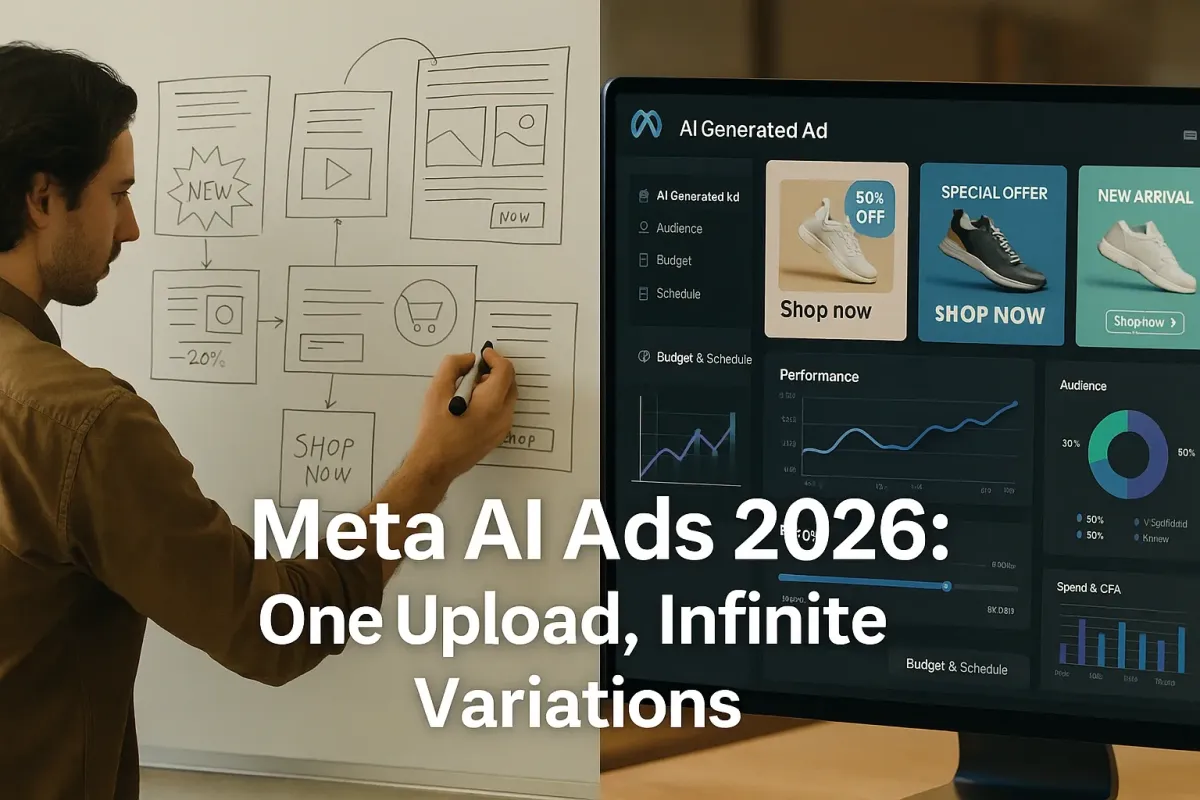
Meta’s Bold Plan to Fully Automate Ads by 2026—Revolution, Reckoning, or a Little of Both?
That Familiar Mix of Awe and Unease
On June 2, Reuters reported that Meta plans to “fully automate advertising with AI by the end of 2026.” The scoop—sourced from a Wall Street Journal piece—sounds almost sci-fi: give Meta a single product image and a budget, and its algorithm will generate the visuals, video, copy, audience, and spend allocation.
Cool, right? Don’t get me wrong—it’s cool and all… but not that useful if you care about nuance. The truth is, there’s a gulf between the promise of friction-free ads and the messy reality of brand voice, compliance, and—yes—human ego.
Let Me Explain the Technical Leap
Meta isn’t starting from scratch. Its Advantage+ suite already lets advertisers automate creative variations and placements. But that’s just it: those tools are step-changes, not the endgame. Meta’s vision—outlined in the WSJ’s deeper dive*—is end-to-end:
Input – An image, URL, or product catalog entry plus a budget ceiling.
Generation – AI crafts ad copy, headlines, videos, carousels, even background music.
Targeting – Real-time audience discovery across Facebook, Instagram, Reels, and whatever metaverse corner survives.
Budget Orchestration – The system reallocates spend on the fly, tweaking bids by geography, user behavior, or time of day.
Dynamic Personalization – Every viewer could see a unique ad variant based on their context and intent.
If that sounds like sci-fi, remember: Meta already tinkers with location-aware creative; TechCrunch covered its image-generation upgrade last year. This is less a leap than a final puzzle piece.
Why Meta Is Betting the Farm
First, follow the money. About 97 % of Meta’s 2024 revenue came from advertising, and its user base tops 3.43 billion monthly actives. Scale like that begs automation—or risk drowning in manual campaign setups.
Second, Meta’s leadership knows generative AI is the new arms race. Google, Amazon, Snap, Pinterest, even Reddit are rolling out similar toolkits. Meta must out-innovate or watch ad dollars drift.
Finally, it’s about owning the whole funnel. Meta already has the eyeballs; automating creative and spend locks advertisers into a one-stop growth machine. Meta’s own blog spells it out: the company “invests tens of billions annually” into AI infrastructure precisely to “maximize every impression.”
The Upside Nobody Can Ignore

Speed to Market – Campaigns go live in minutes, not days.
SMB Empowerment – Solopreneurs skip agency fees.
Granular Personalization – Ads morph by language, weather, or the song you just streamed.
Continuous A/B/n Testing – Every impression feeds the model, sharpening performance without human fiddling.
If you optimize purely for ROAS, this sounds like Christmas morning.
Agency Panic—or Pivot
The announcement rattled holding companies. The WSJ notes shares of Publicis, WPP, and Omnicom slid 3-4 %. Good luck getting anywhere with an hourly-billing model if Meta hands clients a self-serve “easy” button.
Yet agencies aren’t toast; they just need to move up the value chain:
Strategic Narrative → Brand Governance → Prompt Engineering → Outcome-based pricing.
Production work? Automate it. Insight, stewardship, and integration? Human territory.
Brand Builders vs. Performance Pirates
Performance-driven DTCs will embrace Meta’s machine. Clicks talk.
Luxury and heritage brands? Different story. Gucci doesn’t want AI ad-libs calling its bag “cute.” Nuance wins over novelty.
And the larger the brand, the more committees guard tone—one reason Economics Times says big advertisers are “experimenting,” not sprinting.
Real-World Risks You Can’t Ignore
Creative Blandness – AI averages, it rarely innovates.
Brand Safety – Algorithmic placements can misfire—remember the “ads next to extremist content” scandals?
Privacy Backlash – Hyper-personalization feels invasive. Expect regulatory heat.
Data Bias – If the model skews toward certain demos, legal and PR headaches follow.
Job Displacement – Media buyers may dwindle, but new roles in AI ops, data storytelling, and ethics rise.
The truth is, automation never eliminates work; it reshuffles it.
How to Future-Proof Your Marketing Game

A. Learn Prompt Strategy
Treat AI like a junior copywriter: great with guardrails, dangerous without.
B. Build Human Checkpoints
Set approval flows so no rogue headline slips through.
C. Shift to Outcome Contracts
Bill for leads or revenue, not for “number of ad sets uploaded.”
D. Run Micro-Experiments
Pilot AI-only ad groups, benchmark vs. hybrid setups.
E. Train Your Team
Data literacy, ethics, creative judgment—yes, in that order.
Meta’s Spending Signals Commitment
Capex for 2025? Somewhere between $64 B and $72 B, much of it funneling into AI servers and data centers (per Meta’s latest earnings call). That’s not a side project—it’s the main quest.
Competitive Crossfire
Google’s Performance Max, Amazon’s “AI Creative Generator,” and OpenAI’s rumored ad API all circle the same pot. Whoever cracks trust plus automation wins. Meta’s advantage is sheer reach; Google’s is intent data; Amazon’s is purchase behavior. Buckle up.
A Pragmatic Playbook for You

Audit Your Funnel – Where does creativity matter vs. where speed suffices?
Segment by Risk – High-stake launches get human creatives; evergreen promos test AI.
Document Brand Voice – Feed the machine clear style guides. Vague in, bland out.
Negotiate Platform SLAs – Demand transparency on data usage and placement logic.
Invest in Talent – Hire strategists who speak both copy and code.
Final Word: Keep Both Hands on the Wheel
That familiar mix of awe and unease? It’s healthy. Meta’s AI ad engine will change the landscape, but the landscape still needs architects. Machines can scale variations; they can’t replace a point of view.
So experiment aggressively, question relentlessly, and remember: automation is the new electricity—we all plug in, but the brands that thrive will still be the ones with a soul.
Good luck getting anywhere if you leave that part to the bots.
